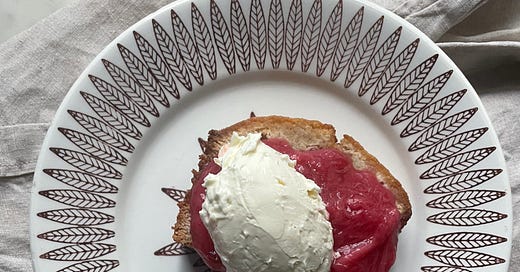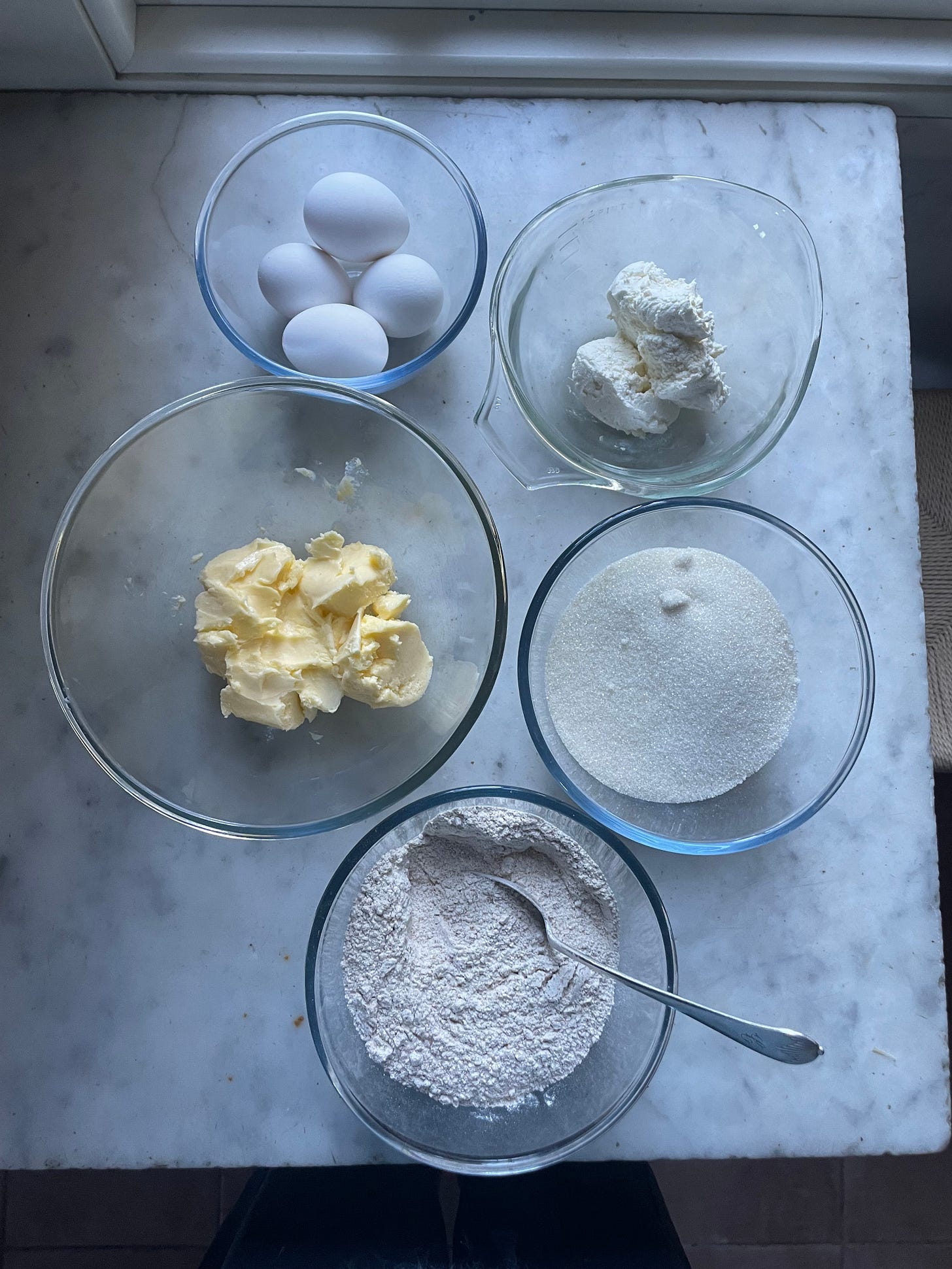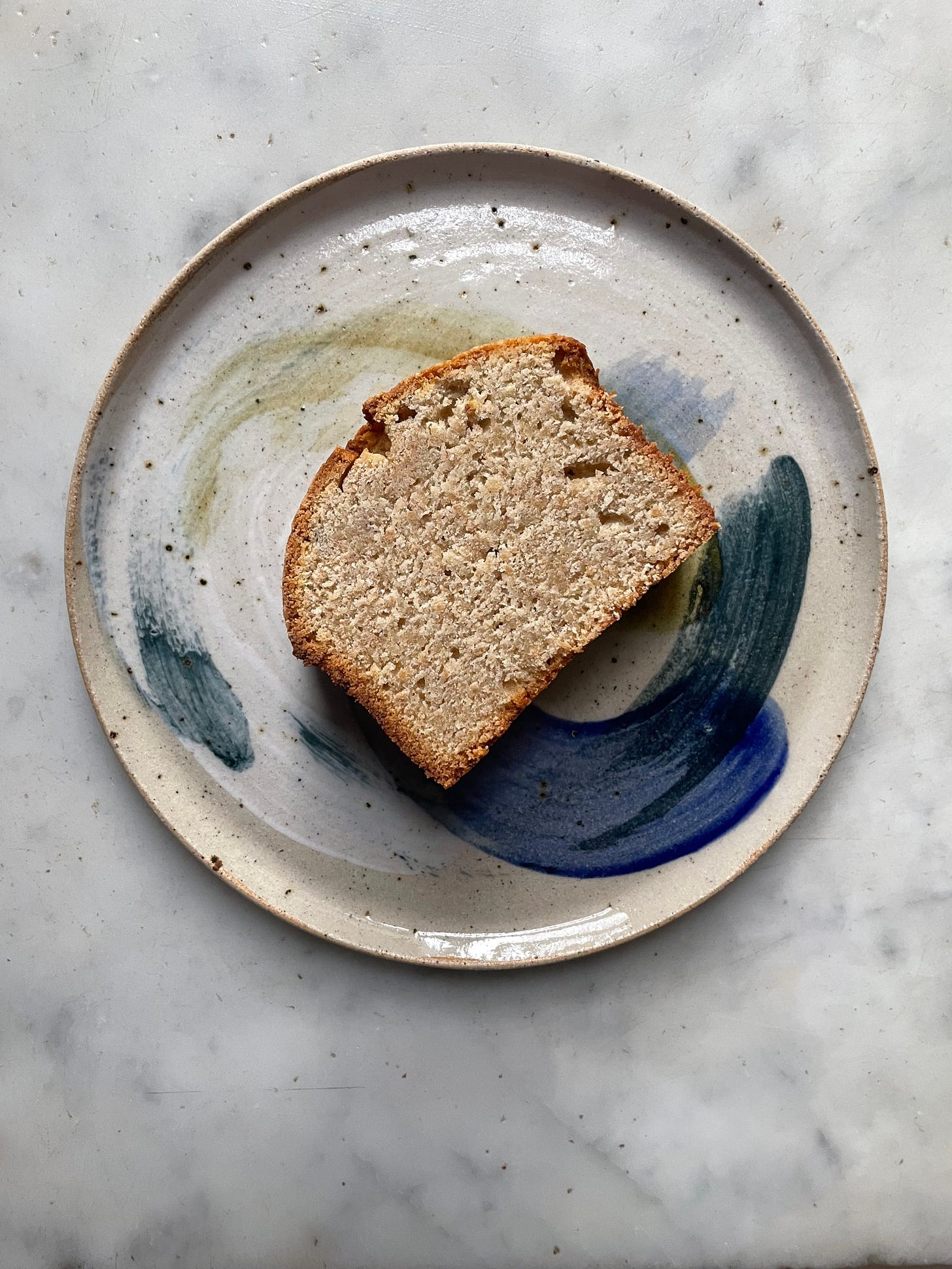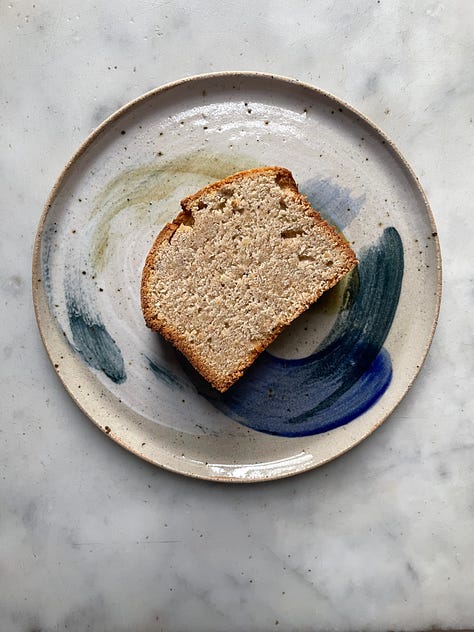
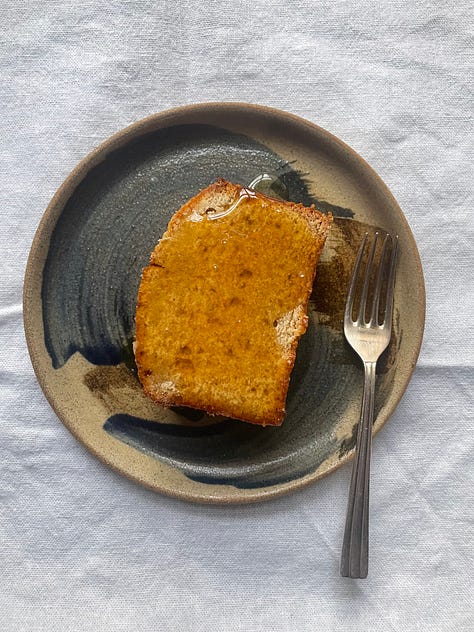
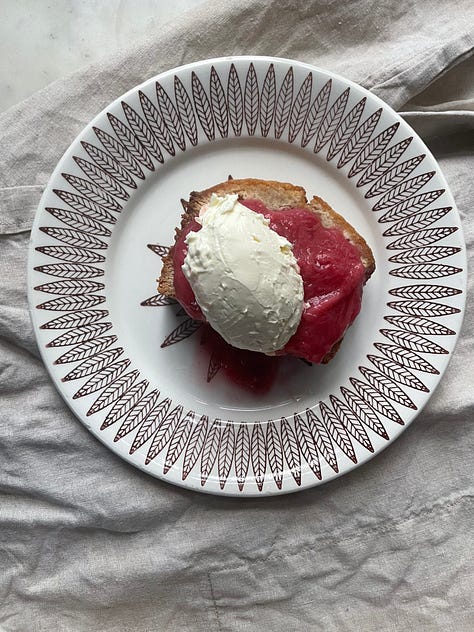
Anna’s the first baker I have met who cooks cakes at a low temperature. I say this because as you read through the recipe, you may otherwise question the 150ºC she calls for you to preheat the oven to. The typical 180ºC attributed to many a bake is not in Anna’s repertoire. Her experience results in her challenging baking conventions to achieve better results. The actual qualities of her baking eschew character, layered with personality, sometimes requiring you to take a bite to appreciate. As humble as this loaf cake might seem, it’s got a personality, accorded by quality ingredients and a unique cooking method.
I hope you enjoy it,
Cúán.
Why I Bake
It began in a bothy. A larch-clad structure with a corrugated metal roof, the Inshriach Bothy stands picturesquely placed and beautifully isolated on the banks of the River Spey. It is hidden among the forested foothills of the Cairngorm mountains and deep in the Scottish Highlands. A lone shelter surrounded by birch trees, alder, Scots-pine and heather. Peace prevails. The sound of rushing water from the snowy plateaus above, the whistle of the northerly winds in the ancient trees and the melody of small forest birds - siskins, tits and finches - provides gentle white noise. This bothy was the site of a week-long artist residency which my partner and I undertook in the late winter of 2013. Our collaborative aim was to create a body of work which would explore the idiosyncrasies of that particular place. Our respective practices were similarly concerned with themes of home, nurture and the elevation of the everyday: drawing people’s attention to the beauty of the mundane; marking the significance of individual moments and places. The presence of a wood-fired oven in the bothy, and a new interest in sourdough culture, meant that baking quickly became our medium. We spent a week obsessively baking sourdough bread in the small oven: bread risen using wild, natural yeasts - yeasts which were occurring, forming and developing in direct response to the particularities of the wild highland air and the specific minerality of the local water. We used the freshest, most local flour we could lay our hands on, and then baked the dough in the oven stoked with local timber - logs and branches gleaned from the surrounding woodland. The breads we baked, as well as pastries and scones, were in the most literal way like eating a place - we were consuming the land, the air and the water - hot from the oven and slathered in butter. To take the project a step further, we distributed the loaves among the local community - exploring remote farm tracks to discover dwellings, leaving loaves, still warm, on doorsteps and passing bounties through open car windows to folk we passed on the winding B970. By sharing the bread in this way we realised the extent to which baking can connect and identify a community. Without fully knowing it, we departed the Inshriach estate where we had arrived as hopeful artists, as bakers about to embark on and devote ourselves to a journey into the world of artisan baking and the community it can create (see Bread at the Bothy).
This notion of baking a place continues to be abstract and moves and interests me in my work. When I think about myself as a baker, whether it be standing in my home kitchen, sitting at my desk or working in a busy bakery, what motivates me to create and therefore to bake is the same. Above an interest in the technical craft, practical process or product, it is first and foremost a desire to express and to inspire: to share experiences of time, place and sentiment. Through baking I want to evoke a sense of connection, realisation and appreciation for both myself and for those who partake. Baking becomes a language by which to communicate, to make note and to celebrate.
At twoeightseven this underlying objective influenced the selection of baked goods we had on offer and the ingredients we used to make them. It was also what distinguished us from other bakeries in the local area. Until recently, a prevailing concern of the modern food industry has been an aim for consistency: that a product consistently tastes, looks and feels the same. This has been supported and facilitated by modern farming and agricultural practice, where monocultures prioritise the industrial, the stable and the profitable. The generic reigns over the distinct at the expense of taste, regionality and the environment. Lack of diversity prevents crops and therefore ingredients from developing distinguishing characteristics due to the damage it does to the land and the soil upon which flavour relies. Consequently, a bag of flour is a bag of flour is a bag of flour. At twoeightseven we sought out the most local producers using the most honest and natural farming methods. We worked with ingredients which looked and tasted specific, which told us about their provenance and production. For example, rather than using huge sacks of brilliant white flour milled to a uniform powder, we chose locally grown grains, milled coarsely and carefully - toasty in colour, smelling deeply of grasses and earth when you ripped open the bag and often containing a range of textures, from fine flour particles to coarse brans and the occasional husk or grass seed. The qualities of the flour would change with the seasons and with the hand of the miller, and consequently the flavours, textures and experience of our bakes would follow suit. We worked with Scotland the Bread, Yorkshire Organics and Mungoswells. Our eggs came from Ramstane Farm in Ayrshire, our dairy from Edinburgh Butter, Grahams, Mossgiel, Connage and Erringtons dairies. Each provided us with ingredients which tasted of their provenience and in their flavour it was possible to detect small changes in production: when the cows moved from shed to pasture, or the hens feed contained more or less rapeseed meal, and even the different ages of the laying birds. We would use these ingredients to make bakes inspired by local culture and tradition: macaroni or samosa pies, scones, Dundee cake, paradise tarts and shortbread. We would also bake items inspired by our experiences and journeys outside of the bakery, bringing back the flavours of other places to our counter, sharing what we experienced with our customers.
While we were travelling in the time between our bakery projects, baking a place became a way of connecting, engaging and exploring. At Smoke Signals Bakery in North Carolina, I baked scones using the resident sourdough, freshly milled local grains, homemade molasses and apples from the roadside. At an adobe house in Santa Fe, we hand-ground local blue corn to bake a cake studded with nuts and fruits from the garden, the cake was then baked in a traditional Forno oven and shared with neighbours. A summertime trip to a Tuscan farmers market resulted in a moist polenta and olive oil cake heaped with sunset peaches. On arriving in foreign climes it is also our ritual to seek out the oldest Forno, boulangerie, bácús, bageri or bēkarī, to taste the heritage and community of a place.
These values also determine our destinations. Currently top of our list is Elmore Mountain Bread, an exceptional bakery in Vermont, North America. They stone-grind local grain for their sourdough bread which is baked in a huge wood-fired oven. The oven is stoked with wood from the surrounding maple trees and as the loaves emerge, they become a warming breakfast slathered with butter and the syrup of those very trees. Perfection.
I am by no means alone in valuing the connection between food and place. There is a whole professional category for foods made in certain places which can only bear their name if they are indeed from that providence, (PDO: Protected Designation of Origin). A famous baked example is the Scottish Dundee Cake. Cakes bearing this name must be baked in the city of Dundee or its environs to a certain recipe. It represents the city’s identity: the value placed on heritage and tradition, and more literally the history of the city’s trade - key importers of the ingredients of the cake: sultanas, almonds, sherry & oranges.
To bring all this into context: when Cúán asked me to contribute to Ómós we talked about writing recipes which might become a part of the offer at Ómós guesthouse. Initially I felt stuck on this point: my baking repertoire isn’t as fine and splendid as I know Ómós will be. But then I started to imagine the guesthouse and to think about Cúán’s careful and incredibly considered approach to the project. I realised that a sense of place will be central to making Ómós so special: it will be the getting there, the arrival and then the experience of being so specifically and particularly there. This experience will be informed and literally coloured by the project’s location on this old estate outside Abbeyleix. Guests will be welcomed into this piece of land and its history to experience the generosity and care of all the details, tiny and huge, curated to make that place most entirely itself.
I want to start with this beginning - imagining the experience of a guest’s arrival where every detail will be imbued with the Irish custom of céad míle fáilte. I picture an open-armed welcome, being guided to a fireside, where local wood spits and crackles - its aroma filling the air, and warming your skin - and there being offered a cup of Irish tea in a vessel hewn from local earth by the hand of a carefully chosen potter, and alongside to be served a simple piece of cake - a symbol of care and a homely welcome. This cake would be a humble slice, but one which would convey Ómós’ values and speak honestly about the particularities of the place, as well as whetting the appetite for the delights to come.
And so, a recipe for a welcome cake: a simple sponge which can become a vehicle for baking a place. A cake which uses the most basic but best quality local ingredients: flour, eggs and dairy, allowing them to impart their flavour and to talk about the terroir of a place and its heritage. In thinking about recipes for the guesthouse, I am keen that they not only use local ingredients, but also celebrate place by referencing Irish bakery traditions. In my initial research, Google suggested The Irish Dairy Cake in a list of traditional cakes - I was intrigued. Further investigation, however, frustratingly yielded little historical evidence to support the notion of this cake being a traditional Irish bake, but here, as an idea, it suits my romantic notions well. Made using two kinds of dairy - butter and cream cheese - the recipe can be appropriated to celebrate the strong tradition of dairy farming in Ireland; a land of lush green pasture and suitably ambient climate. I imagine it being baked across the years in the kitchens of dairy farms, using up surplus, and being taken to market (my ancestors did a similar thing in Wales.) Alongside dairy, it contains only flour, eggs and sugar, no chemical raising agent to complicate flavour. I have thereby taken this potential impostor into the traditional Irish baking repertoire to suggest a perfect template for a cake that can be easily adapted and rewritten to change with the seasons and availability of ingredients.
It would be a great cake to bake on a regular basis - to taste the subtle changes in a place: the soil, the grasses feeding the cows, sheep or goats and the happiness of the hens, its flavour becoming more or less grassy, sweet or sour. It is also a cake which can be dressed up, adaptable to the moment of baking. Here I stand in my kitchen in late February, having just put my first Irish Dairy Cake in the oven, feeling like there isn’t much immediately around to play with, but then as the scent of the baking cake fills the air, I open my eyes, and my senses, and find sage and rosemary growing in the garden and a jar of honey from a beekeeper down the road. Instantly, I am planning that the next time I bake I will finely chop a teaspoon of each herb and fold this into the batter and then glaze the cake with local honey when it comes out of the oven. I become impatient for spring when I could collect cherry or magnolia blossoms to make a syrup with which to glaze the cake, and then summer, when Scottish strawberries are plentiful, I will fold generous pieces through the mixture just before scooping it into the tin. Cream cheese can be crowdie in winter, then soft goat’s curd when the dairy starts producing it in the spring, or if I can get my hands on some, then ricotta made from Ayrshire cow’s milk. So much possibility. My cake excitement is palpable, and I hope that this recipe will make you feel inspired to bake in an engaged and personal way.
Ingredients are the key to the joy of this cake. It is unlikely that you will find what you need in a supermarket: look to farmers markets or small independent retailers; organic or whole-food shops, greengrocers, cheesemongers, or even the counter in your local butcher for local eggs. Some further notes on ingredients:
FLOUR / most of the flavour of a grain comes from its bran and its germ, this means the most flavourful flour will be one which has had the least of this removed: I recommend using a wholemeal pastry flour, grown and milled as locally as possible. Stoneground flour is also more flavourful than roller milled flour as the grains are not subject to such heat during the milling process. Flour and grain are shipped across the world. Bear this in mind when you search for local ingredients - keep your ideals in perspective: within 100 miles is local in flour terms. Also, look for organic or biodiverse flour: these cereals should have been grown with the greatest respect for the land and plant, allowing true flavour to develop. A few examples of good flour producers in the UK and Ireland: Irish Organic Mill in Ireland, Bacheldremill in Wales, Scotland the Bread in Scotland, Field Bakery and Hodmedods in England.
EGGS / happy hens lay the best eggs. Look for local, organic, free range, fresh eggs.
BUTTER / look for butter coming from a single dairy or farm, and being made with the milk of free range cows. Organic is always preferable. A cultured butter will be full of flavour: find the most interesting butter produced closest to home. Salted or unsalted, either will work well in this cake.
CREAM CHEESE / most recipes for Irish Dairy Cake suggest Philadelphia style cream cheese. To really create a sense of place and flavour I encourage you to use a more interesting cheese, so I have translated cream cheese to mean a soft, fresh or curd cheese - this should open your options up to find something local or even try splitting some curds yourself. Look for local ricotta style cheese, soft goat’s cheese or crowdie. If the cheese comes with a lot of liquid make sure you drain it before baking.
SUGAR / It is tricky for most of us to find local sugar. Organic, unrefined sugars will bring more flavour to this cake - I recommend using golden caster sugar or soft light brown sugar, UK grown if possible. I have tried replacing all the sugar in this recipe with local honey. The resulting flavour was extraordinary, however the texture of the cake suffered - there is more work to be done here and it is definitely worth experimenting. What I have done is reduce the amount of sugar compared to the traditional recipes, allowing the flavours of the other ingredients to come through rather than being overpowered by sweetness. I would also encourage you to glaze the cake with a flavourful local honey after the bake to add that other layer of deliciousness.

